Science
[Long Read] Review: Michio Kaku's Latest Is A Tour You Should Definitely Go On
Aravindan Neelakandan
Jun 13, 2021, 04:59 PM | Updated Jul 02, 2021, 05:50 PM IST
Save & read from anywhere!
Bookmark stories for easy access on any device or the Swarajya app.
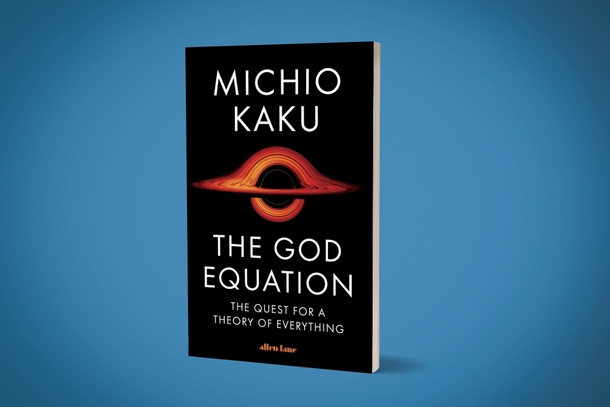

The God Equation: The Quest for a Theory of Everything. Michio Kaku. Doubleday. Pages 240. Rs 1556.
To science enthusiasts, Michio Kaku needs no introduction. He is that physicist of our generation who has contributed profoundly and originally to the field of cutting-edge theoretical physics and also the one who has explained to non-physicists the most complicated of the exotic concepts of ‘New Physics’ – from black holes to multiverses. In his latest book he takes the readers on a journey to one of the ultimate quests of physics – the quest for ‘God Equation’.
What is this ‘God Equation’?
The universe as we know it has four fundamental forces: the electro-magnetic, gravitational, weak and strong nuclear forces. At the ‘instant of the Big Bang, all the four forces were merged into a single super-force that obeyed the master symmetry’, explains Kaku, ‘the equation that governed the super-force was the God equation.’ (p.97)
The book provides a grand tour through the best brains of human species working on some of the ever-enduring questions contemplated. It is a tour every human being with a love for finer and deeper aspects of life should take.
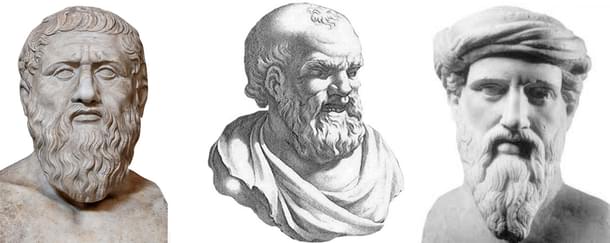
Werner Heisenberg had pointed out the continuity of the clash between the different conceptions of reality right from Plato and Democritus to the debates on new physics. Kaku writes:
So at least two great theories of our world emerged from ancient Greece: the idea that everything consists of invisible, indestructible atoms and that the diversity of nature can be described by the mathematics of vibrations.The God Equation, p. 9
One wonders how modern debates in physics today can be seen in the light of the atomic concepts of ancient Hindu Darshanas, particularly Vaiseshika and Nyaya.
Newton emerged in the West after the interregnum of 1,000 years of darkness that came with the stranglehold of institutional religion. Kaku writes about Newton’s significance:
Before Newton, the church taught that there were two kinds of laws. The first were the laws found on Earth, which were corrupted by the sin of mortals. The second were the pure, perfect, and harmonious laws of the heavens.p. 11
In Hindu tradition there is vidya-avidya. While Christianity divorced the religious knowledge associating it with heavens, vidya-avidya is more inward and outward oriented. The Isavasya Upanishad harmonised vidya-avidya as essential for attaining the truth.
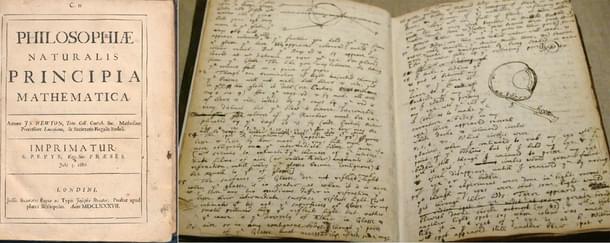
Returning to the book, through all the pages, covering more than two thousand years of physics right upto the current period, one theme runs like a stream – the importance of symmetry:
The concept of symmetry is simple, elegant, and intuitive. Moreover, throughout this book, we will see that symmetry is not just frivolous window dressing to a theory, but in fact is an essential feature that indicates some deep, underlying physical principle about the universe.p.15
Kaku highlights the importance of Michael Faraday. Coming from a backward social background, with no formal education, particularly in mathematics, his discovering of magnetism and electricity as two sides of the same coin advanced physics considerably. He was also the one who discovered the concept of field- ‘one of the most important concepts in all of physics.’ His discovery helped to explain the origin of the magnetic field surrounding the Earth (p. 21).

As we move on to the work of James Clerk Maxwell and his prediction that ‘light consists in the transverse undulations of the same medium which is the cause of electric and magnetic phenomena’, Kaku points out again how symmetry has a crucial presence there also:
Faraday and Maxwell unified electricity and magnetism. And the key to unification is symmetry. Maxwell’s equations contain the symmetry called duality. If the electric within a light beam is represented by E and the magnetic field by B, then the equations for electricity and magnetism remain the same when we switch E and B.p.24
As the propagation of electromagnetic waves is discussed, an Indian will remember Jagadish Chandra Bose demonstrating the use of radio waves propagation two years before Marconi. Peripheral to the book, a mention could have been an interesting tidbit.
Nonetheless, the chapters provide quite stimulating hooks to make the reader rush into the next one. So, at the end of first chapter:
Physicists at that time did not realize that the two great pillars of science, Newton’s and Maxwell’s equations, were actually incompatible. They contradicted each other.p.31
Einstein was born the same year Maxwell died. In the next chapter the quest continues, not just of symmetry but also of unification:
The key to understanding the universe is unification. For relativity, it was the unification of space and time and matter and energy.p.36
Kaku has a gift of showing the reader that the highly specialised theoretical knowledge is more intimate to her than she may realize. While discussing special and general theories of relativity, we may start wondering what relevance all these wild thought-experiments of travelling at the speed of light etc. have to do with day-to-day life.
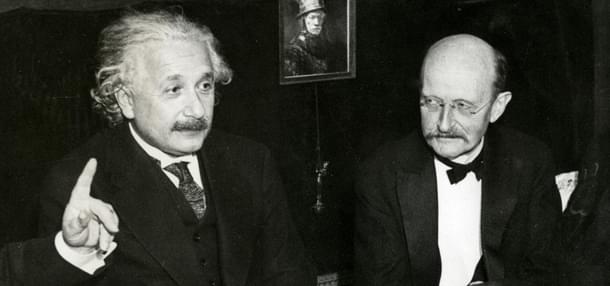
Kaku shows how both general and special theories of relativity play a role in the way GPS works. The computer in the cellphone takes three of the 31 GPS-system related satellites orbiting the planet. The time for and hence the clocks, of the satellites moving at roughly 17,000 miles per hour run slower than their earthen counterparts. On the other-hand being away from terrestrial gravity time speeds up a bit. The former because of special and latter because of general theories of relativity. ‘Your cell phone then factors in both competing effects and tells you precisely where you are located’ writes Kaku: ‘So without special and general relativity working in tandem, you would be lost.’ (pp. 48-49)
Conjectures in the thought experiments of absent-minded physicists are closer to reality than they appear.
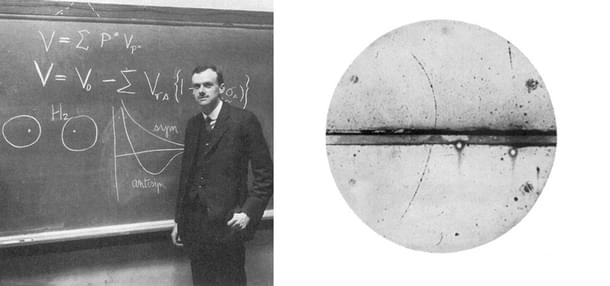
Next chapter, we move into Quantum Mechanics (QM). In popular science writing, this is a well-beaten path. Here also we encounter the eloquent descriptions of all essentials from the double-slit experiment to Schrödinger. Again, the theme of symmetry runs like a distant song faintly heard in a meadow, here too.
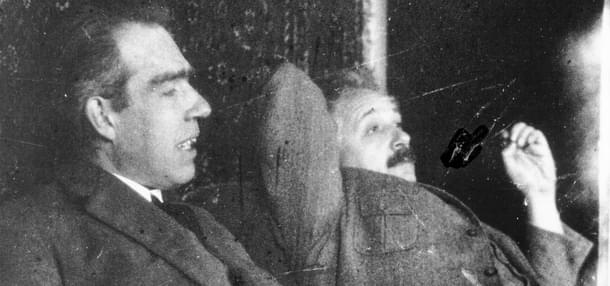
Here's Kaku on the Schrödinger equation:
No matter how powerful the Schrödinger equation was, however, it still had a limitation. It only worked for small velocities—that is, it was nonrelativistic. The Schrödinger equation said nothing about the speed of light, special relativity, and how electrons interact with light via Maxwell’s equations. It also lacked the beautiful symmetry of Einstein’s theory and was rather ugly and difficult to handle mathematically.
And this is about the Dirac equation:
Even more important, the Dirac equation predicted an unexpected new form of matter, called antimatter. Antimatter obeys the same laws as ordinary matter, except it has the opposite charge. So the anti-electron, called the positron, has a positive, not a negative, charge.pp. 64-65
It was in the sixth Solvay conference at Brussels that the full-fledged debate happened between Bohr and Heisenberg on the one hand with Einstein and Schrodinger on the other. One finds a subtle sympathy for Einstein from Kaku here:
Historians agree for the most part that Bohr and the quantum rebels won the debate. Still, Einstein was successful in exposing the cracks in the foundation of quantum mechanics. Einstein showed that it was a towering giant standing on philosophical feet of clay.p. 68
Inside the book we also read how Max Planck spoke to Hitler in his own mild-mannered way, against the exodus of the scientists because of antisemitism, while his own son who plotted to murder Hitler was executed.
The chapter dealing with QM starts with the periodic table. We see there how all the differences in the elements ultimately come down to the number of electrons and protons. Kaku also points out the role QM played in our understanding of the tree of life:
As Charles Darwin had predicted in the previous century, it was now possible to construct the family tree of life on Earth, with every living thing or fossil a member of one branch of this tree. All of this was the product of quantum mechanics. So the unification of the laws of quantum physics not only revealed the secrets of the universe, it also unified the tree of life.p. 87
Here the emphasis is on What is Life of Schrodinger. At least 11 years before Schrodinger, Bohr had considered applying the principle of complementarity derived from QM to the problem of life – in his famous Light and Life (1933) lecture.

Max Delbruck, one of the principal scientists spearheading the early important explorations of molecular biology has told how Bohr insisted that ‘one could look at a living organism either as a living organism or as a jumble of molecules; one could do either, one could make observations that tell where the molecules are, or … tell you how the animal behaves, but there might well exist a mutually exclusive feature, analogous to the one found in atomic physics.’ Though peripheral to the book, this actually shows how deep was the impact that the developing worldviews in new physics held for other sciences.
Next on this wonderful journey, the reader arrives at quarks. The context is the discovery of various sub-atomic particles. Just like Mendeleev before him, Murray Gell-Mann with his quark model not only brought order to the wild number of sub-atomic particles, he could also predict the particles to be discovered just as Mendeleev. Here too the soft melody of symmetry surfaces:
The reason the quark model was able to unify so many particles is because it was based on a symmetry. Einstein, we recall, introduced a four-dimensional symmetry that turned space into time and vice versa. Gell-Mann introduced equations containing three quarks; when you interchanged them inside an equation, the equation remained the same. This new symmetry described the reshuffling of three quarks.p.91
Again, in uniting weak nuclear force and electromagnetism:
To make sense of the weak nuclear force, physicists once again introduced a new symmetry. Since the electron and neutrino were a pair of weakly interacting particles, it was proposed that they could be paired, giving us a symmetry. Then this new symmetry, in turn, could be coupled to the older symmetry of Maxwell’s theory. The resulting theory was called the electroweak theory, which unified electromagnetism with the weak nuclear force.p.93
Kaku also explains the central importance of Higgs Boson to the entire quest for the God-equation. And along with the Big Bang origin, the standard model etc. we move on to black holes. Kaku points out that Einstein considered natural black holes as impossible. It would have been quite interesting again had he also included the famous Arthur Eddington- Chandrasekar episode with regard to black hole formation. Kaku explains quite clearly the contribution of Hawking to black holes study – his application of quantum mechanics to black holes.

There are times when Kaku's language, quite strongly scientific, has a mystic flourish in purely a poetic sense. For example, consider what Kaku says about ‘nothingness’ in a quantum mechanical sense:
In the quantum theory, even nothingness is in a state of constant, churning uncertainty, where electrons and anti-electrons could suddenly jump out of the vacuum, then collide and disappear back into vacuum. So nothingness was actually frothing with quantum activity.p.114
Perhaps similar quantum fluctuations played a crucial role in ushering us in here along with the entire universe as we know it.
A perfectly smooth Big Bang would have violated the uncertainty principle. These ripples eventually expanded with the Big Bang to create the galaxies we see all around us. … This gives us a remarkable new picture of the quantum theory. The very fact that we exist in the Milky Way galaxy, in the presence of billions of other galaxies, is due to these tiny quantum fluctuations in the original Big Bang.p. 133
But then in the book as such there is no mysticism. It is pure science.
In the sixth chapter we come to the string theory.
At the heart of the matter, even inside the quarks, this theory places strings vibrating in ten dimensions. Kaku sees a faint resonance with the Pythagorean universe: 'Like Pythagoras more than two thousand years ago, the theory said that each musical note—each vibration of a string—represented a particle.'
One of the very important features of string theory is ‘how gravity is necessarily included’ in it. Gravity beautifully fits into string theory as 'graviton emerges as one of the lowest vibrations of the string'. Theoretical physicist Edward Witten regards it was a mere historical accident that general relativity predated string theory. To him in another planet it might have been the reverse. Kaku echoes Witten:
‘In fact, even if Einstein had never been born, his entire theory of gravity might have been found simply by looking at the lowest vibration of the string.p.143
Apart from the 10-dimensional strings, there is also the M-theory – discovered by physicist Edward Witten, with a hidden eleventh dimension and which was based on membranes rather than strings. An eleven-dimensional sphere can collapse in five ways into ten-dimensional strings.
One of the strong points of the book is that it does not shy away from the tough criticisms of the very core of the thesis that he holds - criticism for the search of beauty and hence symmetry.
The critics of String theory compare it with Vortex theory, a famous mathematical model used to describe the atoms in the late 19th century which had the support of many famous physicists. But later with the discovery of sub-atomic particles it was abandoned.

In 2013, philosopher Richard Dawid, in his work String theory and the Scientific Method characterised String theory as an example for the use of 'non-empirical theory assessment.' To Dawid, the importance of string theory to the way fundamental nature of philosophy and methodology of science are going to evolve cannot be overstated:
String theory and related theories in contemporary high energy physics and cosmology have substantially changed our perspective on the physical structure of the world. ... First, an analysis of string theory can tell us something about science in general. ... Science cannot be fully grasped in terms of the coherence between physical theory and empirical data. Rather, it has to be seen as an enterprise that binds together observations and theoretical assessments at different levels of analysis in order to obtain its results. .
.. Second, string theory itself changes the epistemic position of physical theory. No prior theory has offered similarly strong foundations for non-empirical theory confirmation; and no prior theory has offered a coherent basis for the formulation of final theory claims. ... The main message to be extracted from the physical status quo at this point thus cannot be that we have a fully-fledged and fully reliable method of non-empirical theory confirmation or that string theory is in fact a final theory. Rather, the novel message is that strategies of non-empirical theory confirmation and strategies of establishing final theory claims have become part of scientific reasoning.
Physicists have not taken kindly to this view. In her book Lost in Math: How Beauty Leads Physics Astray, physicist Sabine Hossenfelder comes down heavily on String theorists. she compared String theory to Stephen King's 1987 novel The Tommyknockers:
King himself called The Tommyknockers ‘an awful book.’ Maybe he has a point there, but it’s a great metaphor for string theory: an alien object of unknown purpose deeply buried in mathematics, and an increasingly fanatical crowd of people with superior intelligence trying to get to the bottom of it.
Not that Hossenfelder does not appreciate the salient features of string theory. Nor does she consider it all fancy:
But for all the controversy that surrounds string theory in the public sphere, within the physics community few doubt its use. Unlike vortex theory, the mathematics of string theory is deeply rooted in theories that demonstrably describe nature: quantum field theory and general relativity. So, we are certain string theory has a connection to the real world. We also know string theory can be used to better understand quantum field theory. But whether string theory really is the sought-after theory of quantum gravity and a unification of the standard-model interactions, we still don’t know.
Kaku agrees that ‘as powerful as beauty is in physics, certainly beauty can often lead you astray’ and quotes Dr. Hossenfelder:
Beautiful theories have been ruled out in the hundreds, theories about unified forces and new particles and additional symmetries and other universes. All these theories were wrong, wrong, wrong. Relying on beauty is clearly not a successful strategy.
While agreeing that there is some validity to this criticism, he points out this:
Not every beautiful theory has a physical application, but all fundamental physical theories found so far, without exception, have a type of beauty or symmetry built into them.p. 163
Perhaps it is time for us to look at reality through the three aspects we see every day under our national television logo– Satyam, Sivam, Sundaram: Empirical validity, Goodness and Beauty.
Goodness or auspiciousness is a feeling deeply connected with the sense of wholeness, completeness. It is the inability to feel this completeness in QM that made Einstein question it as a complete description of reality and that questioning ushered us into EPR paradox and Schrodinger’s cat, if not kittens.
Then comes beauty. Search for these three in any theory in this order can be a good guiding principle. In the words of Kaku: ‘Physicists have realized only in the last few decades that symmetry, instead of being just a pleasing feature of a theory, is actually the central ingredient.’ (p. 147)

Finally, what does all these mean to us and our place in the universe? Kaku mentions a poster he saw in a meditation centre:
Years ago, I saw a strange poster from a meditation society. I recognized that it faithfully published all the details of the supergravity equations, in their full mathematical glory. Attached to each term of the equation, however, there was an arrow that said “peace,” “tranquility,” “unity,” “love,” etc. In other words, the meaning of life was embedded in the equations of the theory of everything.pp. 192-3
Though beautiful, Kaku points out that 'a purely mathematical term in an equation from physics' can hardly be equated to such values. Equations of the universe may not need to embed the values we have evolved to cherish. The values may not need validity and meaning from a theory of strings vibrating in multi-dimensions. But humans need a harmony in both. Can such a harmony be achieved by looking into the sacred accounts of the origins of the diverse religious systems?
Kaku explores:
So where did the Big Bang come from? Most likely, it was a quantum fluctuation in Nothing. Even Nothing, or a pure vacuum, is frothing with matter and antimatter particles continually jumping out of the vacuum and then collapsing back into the vacuum. This is how something came from nothing.p. 192
For a Tamil Hindu, it is impossible, not to remember the lines from the famous Shaktic hymn Abirami Anthathi which describe the Divine Feminine as the ‘nothingness of space from which emerged all physical existence’:
Oh, Parrot Divine (an endearment)
For the devoted seekers
thou art the light of consciousness that enlightens their mind
Thou art also material receptacle of the light
On contemplation, You are the Nothingness
From which expanded the material universe starting from the very space
That such an immeasurable Grandness allows
Herself to be comprehended by
my limited tools of measurement
Is indeed the greatest of the wonders. : verse-16
Kaku harmonizes the 'Eastern’ and Abrahamic worldviews:
Perhaps our universe did have a beginning, as mentioned in the Bible. But perhaps Big Bangs are happening all the time, according to the inflation theory, creating a bubble bath of universes. Perhaps these universes are expanding in a much larger arena, a Nirvana of hyperspace. So our universe had a beginning and is a three-dimensional bubble floating in a much larger space of eleven-dimensional Nirvana in which other universes continually arise.pp. 193-4
Kaku has written the same earlier also. This is from his book seventeen years ago:
Perhaps, scientists speculate, Genesis occurs repeatedly in a timeless ocean of Nirvana. In this new picture, our universe may be compared to a bubble floating in a much larger “ocean,” with new bubbles forming all the time. According to this theory, universes, like bubbles forming in boiling water, are in continual creation, floating in a much larger arena, the Nirvana of eleven-dimensional hyperspace.‘Parallel Worlds: A Journey through creation, higher dimensions and the future of the cosmos’ (2004), p.5
A more appropriate term is Avyakta – from both Shaktic and Jain traditions.
Avyakta usually translated as 'un-manifest' actually means undefinable as in saptabangi. Avyakta is integral with Vyakta or the defined but not vice-versa. She is feminine. As the creatrix behind all forms, the Maha Maya she is Avyakta Namni Paramesa Shakti– Undefinable as Adi Shankara states. Perhaps it is into this ocean of Shakti that all universes with their countless whirling galaxies, hidden dark matter, matted dimensions, solar systems, planets, beings, self-reflecting and otherwise, the deities, and prophets, their enlightenment and their heavens and hells and their visions of apocalypse and armageddon, plunge and reemerge.
Jesuit anthropologist Pierre de Chardin who came from an entirely different tradition, too felt the submergence of the personal theological deity, however cosmic in imagination, in the oceanic Divine Feminine, validating the universality of the latter:
… First, we have the appearance of a reflective monad, and then, to complete it, the formation of an affective dyad. And, after that, and only after that (that is, starting from this first spark) all that we have described follows in sequence -the gradual and majestic development of a Neo-cosmic, of an Ultrahuman, and of a Pan-Christic … All three not only illuminated in their very roots by Intelligence, but also impregnated throughout their entire mass, as though bonded by a unifying cement, by the Universal Feminine.The Heart of Matter, pp.60-1
Thus the image of the eleven dimensional Oceanic Adi Shakti, Maha Maya, Dara Devi of the Buddhists, lost in the Western tradition as Assherah and Matronitthe, harmonizes the impersonal equations and the personal values which bring meaning to our day-to-day life and sustains the civilisation of our species.
And that is why this book is the Goddess equation.
Aravindan is a contributing editor at Swarajya.





